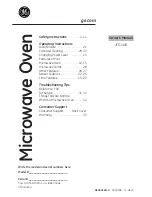
13 TROUBLESHOOTING GUIDE
CAUTION
1. Check grounding before checking for trouble.
2. Be careful of high voltage circuit.
3. Discharge high voltage capacitor.
4. When checking the continuity of the switches or the high voltage transformer,disconnect one lead wire from these parts and then check
continuity with the AC plug removed. To do otherwise may result in a false reading or damage to your meter.
When disconnecting a plastic connector from a terminal, you must hold the plastic connector instead of the lead wire and then disconnect it,
otherwise lead wire may be damaged or the connector cannot be removed.
5. Do not touch any parts of the circuitry on the digital programmer circuit, since static electric discharge may damage this control panel.
Always touch yourself to ground while working on this panel to discharge any static charge in your body.
6. 120V AC is present on the digital programmer circuit (Terminals of power relay´s and primary circuit of low voltage transformer). When
troubleshooting, be cautious of possible electrical shock hazard.
First of all operate the microwave oven following the correct operating procedures in order to find the exact cause of any trouble.
SYMPTOM
CAUSE
CORRECTIONS
1. Oven is dead.
1.
2.
3.
4.
Open or loose lead wire harness
Open thermal cutout (Magnetron)
Open low voltage transformer
Defective DPC
Check fan motor when thermal cutout is
defective.
Fuse is OK.
No display and no operation at all.
2. No display and no operation at all.
Fuse is blown.
1.
2.
Shorted lead wire harness
Defective primary latch switdh (NOTE 1)
Check adjustment of primary, secondary latch
switch and short switch including door.
3. Defective short switch (NOTE 1)
4. Defective Inverter Power Supply (U)
Refer to component test procedure
Refer to Inverter PCB Troubleshooting.
NOTE 1:
All of these switches must be replaced at the same time.
Check continuity of power relay B (RY-1)´s contacts (between 1 and 2) and if it has continuity,
replace power relay B (RY-1) also.
3. Oven does not accept key
input(Program)
1.
2.
Key input is not insequence
Open or loose connection of membrane key pad
to DPC (Flat cable)
Refer to operation procedure.
3. Shorted or open membrane key board
4. Defective DPC
Refer to DPC troubleshooting.
4. Fan motor turn on when oven is
plugged in with door closed.
3. Misadjustment or loose wiring of secondary latch
switch
Adjust door and latch switches.
4. Defective secondary latch switch
5. Timer starts count down but no
microwave oscillation.
(No heat while oven lamp and fan
motor turn on)
1.
2.
Off-alignment of latch switches
Open or loose connection of high voltage circuit
especially magnetron filament circuit
NOTE:
Large
contact
resistance
will
bring
lower
magnetron
filament
voltage
and
causing
magnetron to lower output and/or be intermittent.
Adjust door and latch switches.
3. Defective high voltage component
H.V. Inverter Power Supply (u)
Magnetron
Check high voltage component according to
component test procedure and replace if it is
defective.
4. Open or loose wiring of power relay B (RY-1)
5. Defective primary latch switch
6. Defective DPC or power relay B (RY-1)
Refer to DPC troubleshooting
6. Oven can program but timer does not
start countdown.
1. Open or loose wiring of secondary latch switch
2. Off-alignment of secondary latch switch
Adjust door and latch switches.
3. Defective secondary latch switch
7. Microwave output is low. Oven takes
longer time to cook food.
1. Decrease in power source voltage
Consult electrician
2. Open or loose wiring of magnetron filament
circuit.(Intermittent oscillation)
3. Aging change of magnetron
8. Fan motor turns on and turntable
rotates when door is opened.
1. Shorted primary latch switch
9. Oven does not operate and return to
plugged in mode as soon as start pad
is pressed.
1. Defective DPC
Check tighten screws on escutcheon base
bracket, D.P.C. board.
10. Loud buzzing noise can be heard.
1. Loose fan and fan motor
11. Turntable motor does not rotate.
1. Open or loose wiring of turntable motor
2. Defective turntable motor
12. Oven stops operation during cooking.
1. Open or loose wiring of primary and secondary
latch switch
Adjust door and latch switches.
2. Operation of thermal cutout
23
NN-S262SF / NN-S262BF / NN-S262WF / NN-S252BF / NN-S252WF
Summary of Contents for NNS252BF - MICROWAVE OVEN/OTR
Page 2: ...2 NN S262SF NN S262BF NN S262WF NN S252BF NN S252WF ...
Page 3: ...3 NN S262SF NN S262BF NN S262WF NN S252BF NN S252WF ...
Page 6: ...3 CONTROL PANEL CPH 6 NN S262SF NN S262BF NN S262WF NN S252BF NN S252WF ...
Page 9: ...5 SCHEMATIC DIAGRAM APH 9 NN S262SF NN S262BF NN S262WF NN S252BF NN S252WF ...
Page 10: ...6 SCHEMATIC DIAGRAM CPH 10 NN S262SF NN S262BF NN S262WF NN S252BF NN S252WF ...
Page 27: ...14 EXPLODED VIEW AND PARTS LIST 27 NN S262SF NN S262BF NN S262WF NN S252BF NN S252WF ...
Page 34: ...34 NN S262SF NN S262BF NN S262WF NN S252BF NN S252WF ...














































